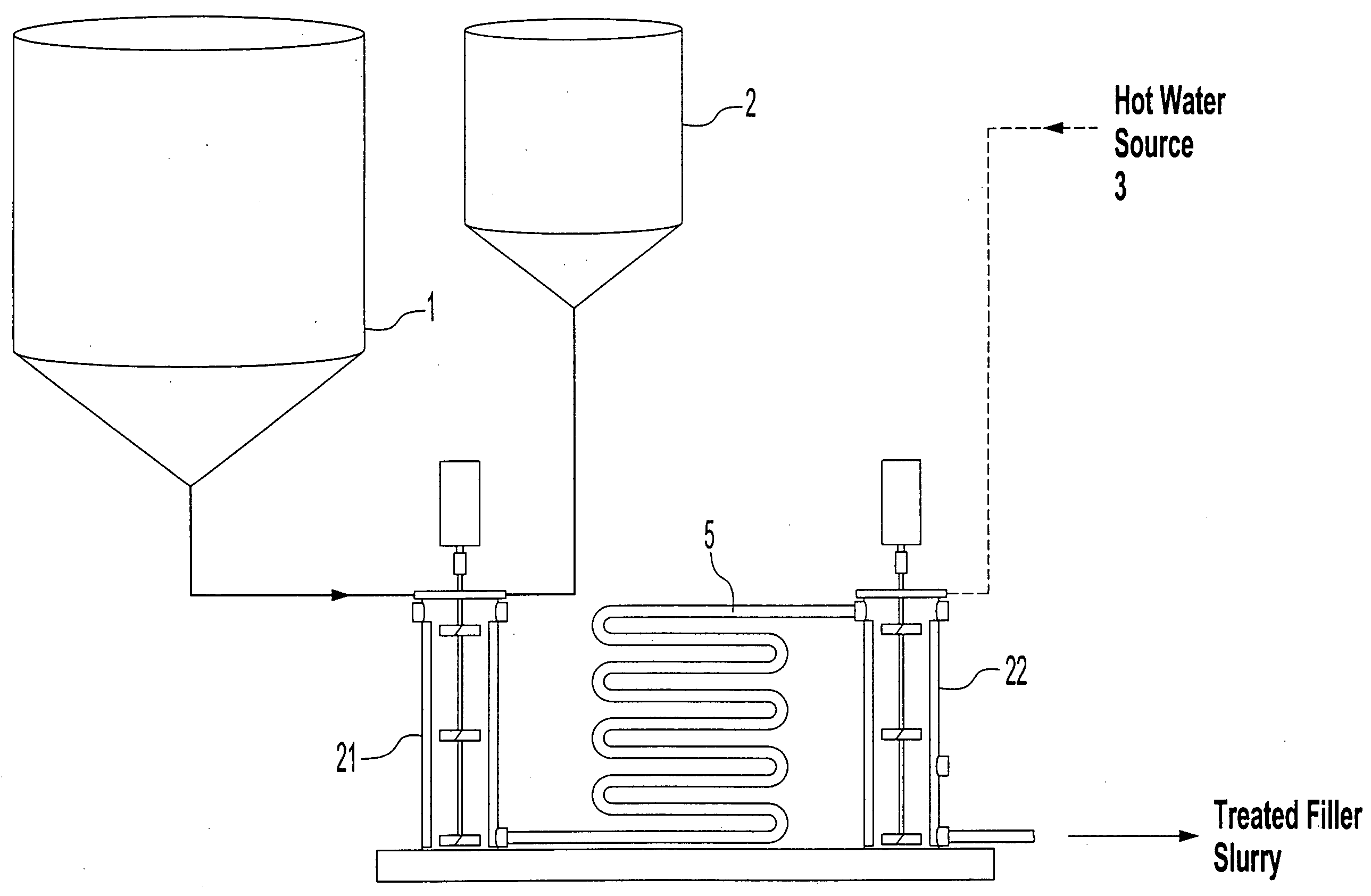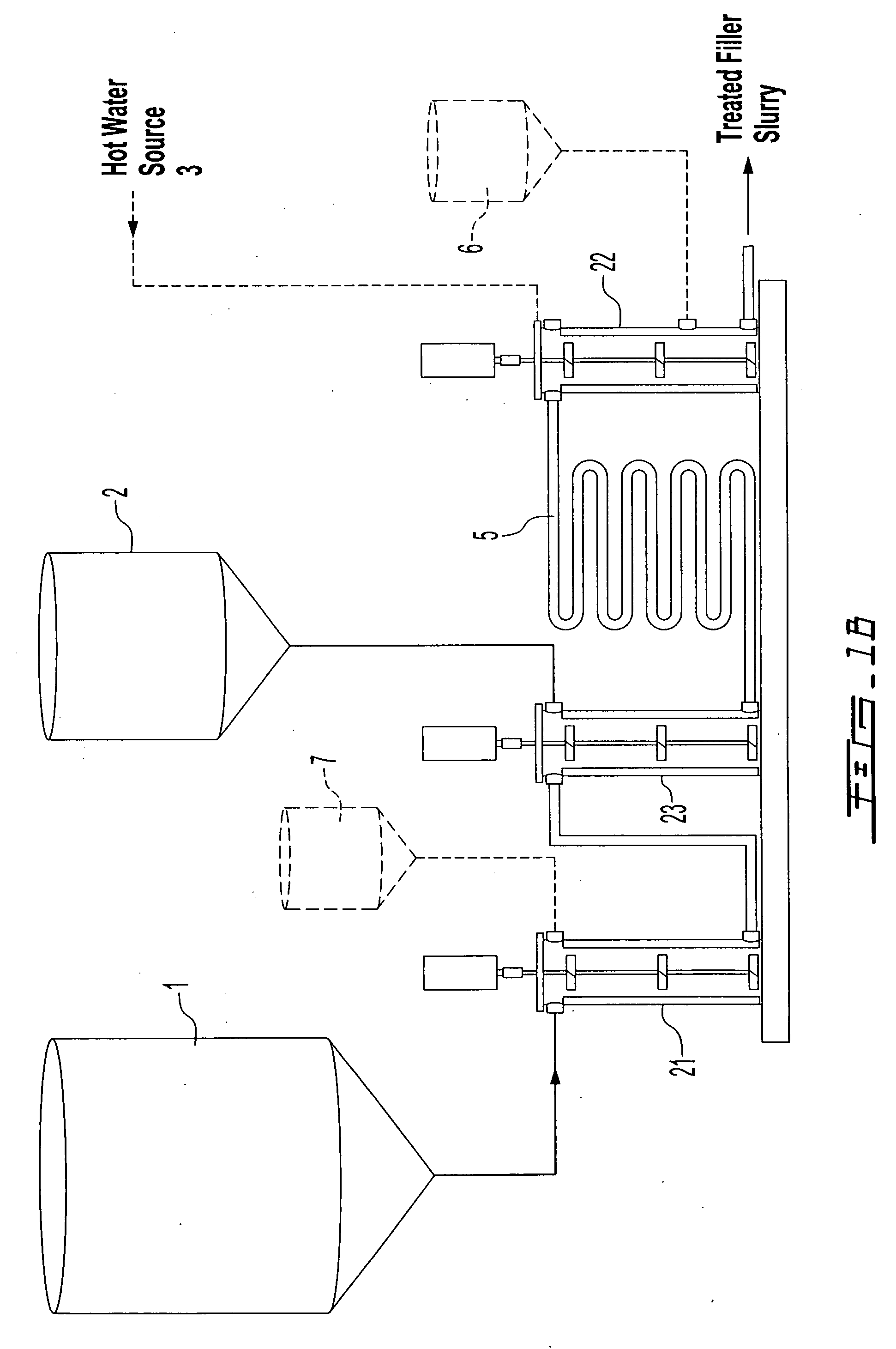Latex-treated filler slurries for use in papermaking
a filler and latex technology, applied in papermaking, textiles and papermaking, emulsion paints, etc., can solve the problems of affecting the amount of filler that can be added to the pulp furnish, affecting the strength of paper, and affecting the internal bond strength, etc., to reduce the tendency of filler, improve retention, and short time
- Summary
- Abstract
- Description
- Claims
- Application Information
AI Technical Summary
Benefits of technology
Problems solved by technology
Method used
Image
Examples
example 1
[0103]FIGS. 2a and 2b show the filtrate turbidity of PCC slurries treated with three acrylic polymer dispersions of different Tg values (resins #1, #2 and #3 of Table 1) each used at three added water temperatures. The latex at room temperature (RT) (22° C.) was added to the PCC slurry (50 kg latex / ton filler) at RT and 600 rpm. The mixture was divided into three samples: the first sample was mixed with water at 22° C., the second sample was mixed with 50° C. water and the third sample was mixed with 80° C. water to obtain samples with 10% consistency. The temperature of the samples was 22, 38 and 47° C., respectively. The samples were further diluted to 2% with the corresponding hot waters to measure turbidity of the supernatant filtrate. The equivalent temperatures of the 2% slurries were 22, 46, 67° C., respectively. The turbidity of the supernatant of the diluted samples was recorded over time. The effect of diluting the untreated PCC slurry with water of different temperatures ...
example 2
[0107]FIGS. 3 and 4 present the internal bond strength (Scott bond) and porosity of 70 g / m2 sheets made with different levels of PCC (latex-treated and untreated slurries) at pH 8.2. Treated PCC slurries were prepared with the commercial Acronal resins (Table 1) of different glass transition temperatures at 50° C. The retention aid system was 0.03% CPAM (cationic polyacrylamide) / 0.3% Bentonite.
[0108]FIGS. 3 and 4 show that in the absence of PCC treatment with Acronal latex the internal bond strength dropped linearly as the PCC level increased and the sheets became more porous (i.e., had a more open structure). PCC treatment with 0.6% latex followed by mixing for 60 seconds at 400 rpm with hot water at 50° C. improved the internal bond strength and reduced the porosity of handsheets. The best results, i.e., the highest Scott bond strength at a given sheet ash content, were obtained with the latex of the lowest Tg. This latex also gave sheets with the lowest porosity.
example 3
[0109]FIGS. 5 and 6 present the internal bond strength of 70 g / m2 sheets made from a similar pulp furnish to the one used in Example 1. Treated PCC slurries were prepared with three laboratory Acronal latexes of different glass transition temperatures and different mean particle sizes (Table 2). The temperature of the hot water was maintained at 50° C. The retention aid system used during sheet making was 0.03% CPAM / 0.3% Bentonite.
[0110]The FIGS. 5 and 6 show that in the absence of PCC treatment the internal bond strength dropped as the PCC level increased. However, PCC treatment with 0.6% resin followed by mixing with hot water (hot water temperature 50° C.) for 60 seconds at 400 rpm improved internal bond strength. The best results were obtained with the resin of Tg 6° C. (resins 5 and 6). The particle size of resin dispersion, 140 nm or 200 nm, also had an effect on the resin performance for strength.
PUM
| Property | Measurement | Unit |
|---|---|---|
| Temperature | aaaaa | aaaaa |
| Weight | aaaaa | aaaaa |
| Length | aaaaa | aaaaa |
Abstract
Description
Claims
Application Information
 Login to View More
Login to View More - R&D
- Intellectual Property
- Life Sciences
- Materials
- Tech Scout
- Unparalleled Data Quality
- Higher Quality Content
- 60% Fewer Hallucinations
Browse by: Latest US Patents, China's latest patents, Technical Efficacy Thesaurus, Application Domain, Technology Topic, Popular Technical Reports.
© 2025 PatSnap. All rights reserved.Legal|Privacy policy|Modern Slavery Act Transparency Statement|Sitemap|About US| Contact US: help@patsnap.com



